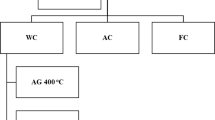Abstract
The electrochemical behaviour of Ti–Ni shape memory alloy and Co–Cr alloys were investigated in dynamic Tyrode’s simulated body fluid on a Model CP6 Potentiostat/Galvanostat. The results indicated that, for all alloys, the anodic dissolution and the pitting sensitivity increased with the flow rate of the Tyrode’s solution increasing while the open-circuit potentials and pitting corrosion potentials decreased with the Tyrode’s solution increasing. Pitting corrosion of Ti–Ni alloy was easier than Co–Cr alloys. Since the solution’s flow enhanced oxygen transform and made it easy to reach the surface of electrodes, the plateau of oxygen diffusion control was diminished. All these indicated that the cathodic reduction and the corrosion reaction, which was controlled by the electrochemical mass transport process, were all accelerated in dynamic Tyrode’s simulated body fluid.





Similar content being viewed by others
References
Rondelli G, Vicentini B, Cigada A. The corrosion behaviour of nickel titanium shape memory alloys. Corros Sci. 1990;30:805–19.
Chenghao L, Haixia G. The effect of fibrinogen on the electrochemical behaviour of cobalt alloys in PBS solution. Chin J Biomed Eng. 2003;12:59–65.
Duan Y, Liu K, Chen J. Effect of simulated body fluid flowing rate on bone-like apatite formation on porus calcium phosphate ceramics. Space Med Med Eng. 2002;15:203–7. (in Chinese).
Chenghhao L, Liang G, Wan C, et al. Electrochemical behavior of SUS316L stainless steel after surface modification. Trans Nonferrous Metals Soc China. 2003;13:398–401.
Pu S. Metallic implant materials and corrosion. Beijing: Beijing University of Aviation and Space flight; 1990. p. 62–6.
Jones DA. Electrochemical measurement of low corrosion rate. Corros NACE. 1966;22:198–205.
Kazuhiko E. Corrosion resistance of Ni-containing alloys. In: Corrosion and protection 126th conference. Tokyo; 1999. p. 36–45.
Acknowledgements
The author wishes to express her most sincere appreciation to Prof. H. Wang, who gave valuable advice during the experiments. Tremendous thanks were owed to Dr. W. Chen for the figures analysis.
Author information
Authors and Affiliations
Corresponding author
Rights and permissions
About this article
Cite this article
Liang, C., Zheng, R., Huang, N. et al. Electrochemical behaviour of Ti–Ni SMA and Co–Cr alloys in dynamic Tyrode’s simulated body fluid. J Mater Sci: Mater Med 21, 1421–1426 (2010). https://doi.org/10.1007/s10856-010-4002-z
Received:
Accepted:
Published:
Issue Date:
DOI: https://doi.org/10.1007/s10856-010-4002-z




